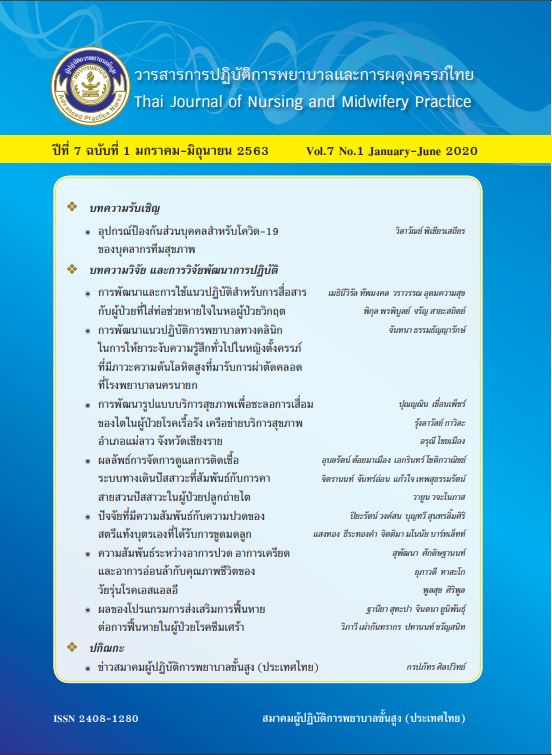Outcomes of Catheter Associated Urinary Tract Infection (CAUTI) Care Management in Kidney Transplant Recipients
Main Article Content
Abstract
Catheter associated urinary tract infection (CAUTI) in kidney transplant recipients is a common and complicated problem that had impacted on the length of hospital stay, medical expenses, functioning of the transplanted kidney, kidney transplant rejection, septicemia, and death rate. This retrospective study analyzed and compared the outcomes of care management to reduce CAUTI in the new kidney transplant recipients who had an operation during 2003-2011. The sample of 278 persons were recruited based on the inclusion criteria. Data were collected by instruments developed by the researchers. Instrument was validated by 3 experts, and its content validity was 0.87. The outcomes of care management for 3 months after the kidney transplant were analyzed and compared between 2 periods: 2003-2006 and 2007-2011 using statistics of Mann-Whitney U test, Chi-square test, Fisher’s exact test and Multiple logistic regression. Results revealed that the occurrence of CAUTI (p<.001), the length of hospital stay (p<.001), medical expense (p<.001), septicemia (p = .007) , and kidney transplant rejection (p = .018) in the 2nd period were decreased more than the 1st period with statistically significance. Additionally, the 3-month estimated glomerular filtration rate after kidney transplant (eGFR) (p = .021) in the 2nd period were increased more than the 1st period with statistically significance. The continuous development of structure and process of CAUTI care management quality in kidney transplant recipients can lower rate of CAUTI occurrence resulting in better clinical outcomes. The outcomes of CAUTI care management should be examined as a long-term prospective cohort study.
Downloads
Article Details
References
Toimamueang U, Chotikawanich E, Thepsuthammarat K, Anunnatsiri S, Vajanaopath V. Incidence and risk factors of catheter associated urinary tract infection among kidney transplant recipients. Journal of Nursing and Health Care 2015; 33(1): 115-26. (In Thai)
Wu X, Dong Y, Liu Y, Li Y, Sun Y, Wang J, Wang S. The prevalence and predictive factors of urinary tract infection in patients undergoing renal transplantation: A meta-analysis. Am J Infect Control 2016;44(11):1261-8.
Mohan MV, Neeraja M, Sudhaharan S, Raju SB, Gangadhar T, Lakshmi V. Risk factors for urinary tract infections in renal allograft recipients: Experience of a tertiary care center in Hyderabad, South India. Indian J Nephrol 2017;27(5):372.
Fiorentino M, Pesce F, Schena A, Simone S, Castellano G, Gesualdo L. Updates on urinary tract infections in kidney transplantation. J Nephrol 2019;32(5):751-761.
Hsueh PR, Hoban DJ, Carmeli Y, Chen SY, Desikan S, Alejandria M, et al. Consensus review of the epidemiology and appropriate antimicrobial therapy of complicated urinary tract infections in Asia Pacific region. J Infect 2011;63(2):114-23.
Feneley RC, Kunin CM, Stickler DJ. An indwelling urinary catheter for the 21st century. BJU Int 2012;109(12):1746-9.
Bodro M, Sanclemente G, Lipperheide I, Allali M, Marco F, Bosch J, et al. Impact of urinary tract infection on short-term kidney graft outcome. Clin Microbiol Infect 2015 ;21(12):1104.e1.
Ariza-Heredia EJ, Beam EN, Lesnick TG et al: Impact of urinary tract infection on allograft function after kidney transplantation. Clin Transplant 2014; 28(6): 683–90.
Ooms L, Ijzermans J, In’t Holt Voor A, Betjes M, Vos M, Terkivatan T. Urinary tract infections after kidney transplantation:A Risk Factor Analysis of 417 Patients. Ann Transplant 2017;22:402-8.
Gołębiewska JE, Dębska-Ślizień A, Rutkowski B. Urinary tract infections during the first year after renal transplantation:one center’s experience and a review of the literature. Clin Transplant 2014 ;28 (11):1263-70.
Olenski S, Scuderi C, Alex CH, SINGH AK, Mandy WA, Jeyaseelan L, et al. Urinary tract infections in renal transplant recipients at a quaternary care centre in Australia. BMC Nephrol 2019 ;20(1):1-7.
Donabedian A. Evaluating the quality of medical care. Milbank Quart 2005;83(4):691-729.
Dhavee Sirivongs . editor. Manual for traing and clinical practice. Division of Nephrology, Internal Medicine Department, Faculty of Medicine, Khon Kaen University, Khon Kaen: Faculty of Medicine, Khon Kaen University ; 2009 (In Thai) .
Klompanya T, Saensom D. Effects of a clinical nursing practice guideline for catheter-associated urinary tract infection on selected outcomes in Khon Kaen Hospital. Journal of Nursing Science and Health 2018;41(4):34-43. (In Thai)
Chopchai B, Paiboon M, Buthakeaw P, Thaninsurat N, Khansawai R. Development of model of advanced nursing practice in Srinagarind Hospital. Journal of Nurses’ Association Of Thailand, North-Eastern Division 2012; 30(4): 124-131. (In Thai)
Toimamueang U, Sirivongs D, Limumnauy S, Kuchaisit C, Pongskul C. Impact of advanced practice nursing on outcomes of kidney transplantation. Proceeding of the conference of the Nurses’ Association of Thailand North Eastern Division ; 2009 August 14-15; Charoen Thani Hotel Khon Kaen: Klungnana;2009. p.28-37. (In Thai)
Guler S, Cimen S, Hurton S, Molinari M. Risks and benefits of early catheter removal after renal transplantation. Transplant Proc 2015; 47(10):2855-9.
Meddings J, Rogers MA, Macy M, Saint S. Systematic review and meta-analysis: reminder systems to reduce catheter-associated urinary tract infections and urinary catheter use in hospitalized patients. Clin Infect Dis 2010;51(5):550-60.
Bernard MS, Hunter KF, Moore KN. A review of strategies to decrease the duration of indwelling urethral catheters and potentially reduce the incidence of catheter-associated urinary tract infections. Urol Nurs 2012;32(1): 29-37.
Hamilton EE. A nurse-driven protocol to reduce catheter-associated urinary tract infections [Internet] [D.N.P.]. [Ann Arbor, United States]; 2018 [cited 2020 May 13]. Available from: https://search. proquest.com/pqdtglobal/docview/2154870539/ abstract/3A921C4834E6428CPQ/1
Lorenz EC, Cosio FG. The impact of urinary tract infections in renal transplant recipients. Kidney Int 2010;78(8):719-21.


